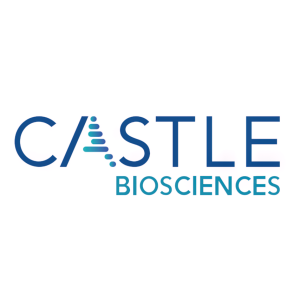Castle Biosciences Presents New Data at ASDS from Prospective, Multicenter CONNECTION Study Supporting Use of DecisionDx®-Melanoma to Guide SLNB Decisions in T1a Tumors with High-Risk Features and T1b Tumors
Data from prospective, multicenter CONNECTION study indicate that using DecisionDx-Melanoma test results to guide sentinel lymph node biopsy (SLNB) decisions in patients with T1 melanoma tumors could have reduced the number of unnecessary biopsies by up to
New findings support DecisionDx®-SCC’s use in guiding radiologic surveillance imaging in patients with stage T2b squamous cell carcinoma (SCC) tumors based on Brigham and Women's Hospital (BWH) staging, including deferring imaging for patients with low-risk test results and proceeding with imaging for patients with high-risk results
“While staging is an important part of skin cancer risk assessment, well-validated molecular tests like DecisionDx-Melanoma and DecisionDx-SCC are designed to look deeper into the biology of a patient’s tumor to provide additional insight into its likely behavior,” said Etan Marks, D.O., board-certified pathologist, laboratory director and primary investigator at Advanced Dermatology and Cosmetic Surgery in
Details regarding Castle’s video abstracts presented at ASDS are included below:
DecisionDx-Melanoma
- Title: The i31-GEP identifies patients with T1 cutaneous melanoma who can safely avoid sentinel lymph node biopsy: Results from a prospective, multicenter study
-
Lead Author: Etan Marks, D.O., Advanced Dermatology and Cosmetic Surgery,
Delray Beach, Florida -
Key take-aways:
National Comprehensive Cancer Network® (NCCN) guidelines regarding SLNB are most ambiguous for patients with T1a tumors with high-risk features and T1b tumors, for whom SLNB may be considered due to an increased risk of metastasis. Data from this ongoing prospective, multicenter study (CONNECTION) confirm that DecisionDx-Melanoma can identify patients with T1 tumors with a low risk of sentinel lymph node positivity who can safely forgo SLNB (negative predictive value of98.4% ), while maintaining very high survival rates in low-risk patients who did not have an SLNB (three-year recurrence free survival rate of99.5% ).1 Additionally, the data indicate that using DecisionDx-Melanoma test results to guide SLNB decisions in patients with T1 tumors could have reduced the number of unnecessary biopsies by up to64% , as well as procedure-related complications and health care costs. - View video abstract here.
DecisionDx-SCC
- Title: The 40-gene expression profile (40-GEP) test enhances risk-aligned guidance for surveillance imaging in high-risk cutaneous squamous cell carcinoma (cSCC)
-
Lead Author: Emily S. Ruiz, M.D., MPH, Brigham and Women’s Hospital and Harvard Medical School,
Boston -
Key take-aways:
Radiologic surveillance imaging in patients with high-risk SCC can identify disease recurrence earlier, which may improve patient outcomes. This study evaluated the utility of the DecisionDx-SCC test in guiding these decisions in patients with higher stage disease (i.e., patients with BWH T2b SCC tumors), whom studies have shown are at a higher likelihood of nodal or distant metastasis relative to lower-staged patients. In the study, approximately42% of the patients with T2b tumors who received radiologic surveillance imaging received a Class 1 (low risk) test result and had a metastasis rate of5.9% , indicating that clinicians could have safely deferred surveillance imaging for these Class 1 patients due to the low metastatic rate. For patients who were not imaged, almost50% received a Class 2A or 2B (higher or highest risk) test result and had an18.8% metastasis rate, suggesting that these patients may have benefitted from imaging to promote early detection of disease progression and improved outcomes. Overall, these data demonstrate the utility of DecisionDx-SCC to help improve selection of BWH T2b patients for radiologic surveillance imaging based on their biological risk of metastasis, as provided by the test. - View video abstract here.
About DecisionDx®-Melanoma
DecisionDx-Melanoma is a gene expression profile risk stratification test. It is designed to inform two clinical questions in the management of cutaneous melanoma: a patient’s individual risk of sentinel lymph node positivity and a patient's personal risk of melanoma recurrence and/or metastasis. By integrating tumor biology with clinical and pathologic factors using a validated proprietary algorithm, DecisionDx-Melanoma is designed to provide a comprehensive and clinically actionable result to guide risk-aligned patient care. DecisionDx-Melanoma has been shown to be associated with improved patient survival and has been studied in more than 10,000 patient samples. DecisionDx-Melanoma’s clinical value is supported by more than 50 peer-reviewed and published studies, providing confidence in disease management plans that incorporate the test’s results. Through June 30, 2024, DecisionDx-Melanoma has been ordered more than 173,000 times for patients diagnosed with cutaneous melanoma. Learn more at www.CastleBiosciences.com.
About DecisionDx-SCC
DecisionDx-SCC is a 40-gene expression profile test that uses an individual patient’s tumor biology to stratify risk of metastasis in patients with cutaneous squamous cell carcinoma who have one or more NCCN high-risk factors. The test result, in which patients are stratified into a Class 1 (low), Class 2A (higher) or Class 2B (highest) risk category, predicts individual metastatic risk to inform risk-appropriate management and guide decision-making regarding the use of adjuvant radiation therapy. Peer-reviewed publications have demonstrated that DecisionDx-SCC is an independent predictor of metastatic risk and that the test can significantly improve risk-stratification when used with traditional staging systems and clinicopathologic risk factors to guide risk-aligned management and treatment decisions. Learn more at www.CastleBiosciences.com.
About Castle Biosciences
Castle Biosciences (Nasdaq: CSTL) is a leading diagnostics company improving health through innovative tests that guide patient care. The Company aims to transform disease management by keeping people first: patients, clinicians, employees and investors.
Castle’s current portfolio consists of tests for skin cancers, Barrett’s esophagus, mental health conditions and uveal melanoma. Additionally, the Company has active research and development programs for tests in other diseases with high clinical need, including its test in development to help guide systemic therapy selection for patients with moderate-to-severe atopic dermatitis, psoriasis and related conditions. To learn more, please visit www.CastleBiosciences.com and connect with us on LinkedIn, Facebook, X and Instagram.
DecisionDx-Melanoma, DecisionDx-CMSeq, i31-SLNB, i31-ROR, DecisionDx-SCC, MyPath Melanoma, DiffDx-Melanoma, TissueCypher, IDgenetix, DecisionDx-UM, DecisionDx-PRAME and DecisionDx-UMSeq are trademarks of Castle Biosciences, Inc.
Forward-Looking Statements
This press release contains forward-looking statements within the meaning of Section 27A of the Securities Act of 1933, as amended, and Section 21E of the Securities Exchange Act of 1934, as amended, which are subject to the “safe harbor” created by those sections. These forward-looking statements include, but are not limited to, statements concerning: the ability of the DecisionDx-Melanoma test to (i) reduce the number of unnecessary biopsies in patients with T1 melanoma tumors and (ii) reduce procedure-related complications and health care costs; the ability of DecisionDx-SCC to guide radiologic surveillance imaging in patients with SCC tumors; the ability of DecisionDx-Melanoma and DecisionDx-SCC to (i) provide additional insight into the likely behavior of a patient’s tumor, (ii) enhance clinical decision-making and (iii) arm clinicians with more precise risk information to help route patients to the most appropriate modality aligned to their risk of metastasis and survival . The words “believe,” “can,” “could,” “potential” and similar expressions are intended to identify forward-looking statements, although not all forward-looking statements contain these identifying words. We may not actually achieve the plans, intentions or expectations disclosed in our forward-looking statements, and you should not place undue reliance on our forward-looking statements. Actual results or events could differ materially from the plans, intentions and expectations disclosed in the forward-looking statements that we make. These forward-looking statements involve risks and uncertainties that could cause our actual results to differ materially from those in the forward-looking statements, including, without limitation: subsequent study or trial results and findings may contradict earlier study or trial results and findings or may not support the results obtained in these studies, including with respect to the discussion of our tests in this press release; actual application of our tests may not provide the aforementioned benefits to patients; and the risks set forth under the heading “Risk Factors” in our Annual Report on Form 10-K for the year ended December 31, 2023, our Quarterly Report on Form 10-Q for the quarter ended June 30, 2024 and in our other filings with the SEC. The forward-looking statements are applicable only as of the date on which they are made, and we do not assume any obligation to update any forward-looking statements, except as may be required by law.
-
Guenther JM, et al. Patients who forego sentinel lymph node biopsy after 31-GEP testing are not harmed: A prospective, multicenter analysis. Poster presented at: 20th European Association of Dermato-Oncology (EADO) Congress; April 4-6, 2024;
Paris, France . https://eado2024.com/wp-content/uploads/2024/04/EADO2024Book_of_Abstracts.pdf
View source version on businesswire.com: https://www.businesswire.com/news/home/20241020950283/en/
Investor Contact:
Camilla Zuckero
czuckero@castlebiosciences.com
Media Contact:
amarshall@castlebiosciences.com
Source: Castle Biosciences Inc.









